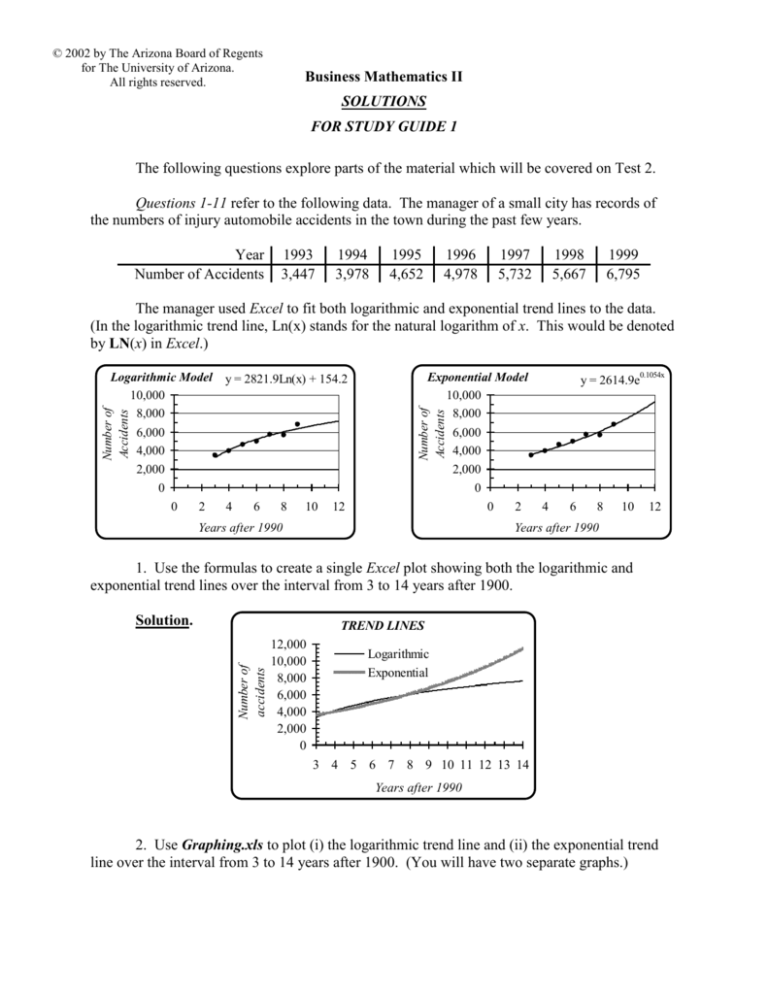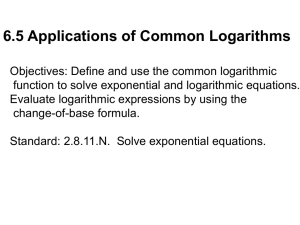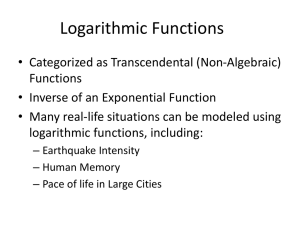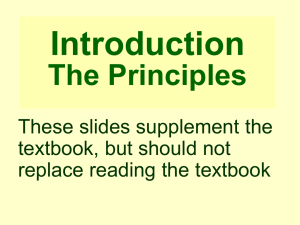
© 2002 by The Arizona Board of Regents
for The University of Arizona.
All rights reserved.
Business Mathematics II
SOLUTIONS
FOR STUDY GUIDE 1
The following questions explore parts of the material which will be covered on Test 2.
Questions 1-11 refer to the following data. The manager of a small city has records of
the numbers of injury automobile accidents in the town during the past few years.
Year
Number of Accidents
1993
3,447
1994
3,978
1995
4,652
1996
4,978
1997
5,732
1998
5,667
1999
6,795
The manager used Excel to fit both logarithmic and exponential trend lines to the data.
(In the logarithmic trend line, Ln(x) stands for the natural logarithm of x. This would be denoted
by LN(x) in Excel.)
Exponential Model
10,000
8,000
6,000
4,000
2,000
0
0
2
y = 2614.9e0.1054x
Number of
Accidents
y = 2821.9Ln(x) + 154.2
Number of
Accidents
Logarithmic Model
10,000
8,000
6,000
4,000
2,000
0
0
2
4
6
8
10
12
Years after 1990
4
6
8
10
12
Years after 1990
1. Use the formulas to create a single Excel plot showing both the logarithmic and
exponential trend lines over the interval from 3 to 14 years after 1900.
Solution.
Number of
accidents
TREND LINES
12,000
10,000
8,000
6,000
4,000
2,000
0
Logarithmic
Exponential
3 4 5 6 7 8 9 10 11 12 13 14
Years after 1990
2. Use Graphing.xls to plot (i) the logarithmic trend line and (ii) the exponential trend
line over the interval from 3 to 14 years after 1900. (You will have two separate graphs.)
- Solutions for Study Guide for Business Mathematics II, Test 1: page 2 -
Solution.
FUNCTION
FUNCTION
8000
7000
6000
5000
f (x ) 4000
3000
2000
1000
0
14000
12000
10000
f (x )
8000
6000
4000
2000
0
0
5
10
x
15
0
5
10
15
x
3. Use the logarithmic equation to predict the number of injury automobile accidents in
2002.
Solution. The logarithmic model predicts 2821.9Ln(2002 1990) + 154.2 7,166
injury accidents in 2002.
4. Use the exponential equation to predict the number of injury automobile accidents in
2002.
Solution. The exponential model predicts 2614.9e0.1054(2002 1990) 9,263 injury
accidents in 2002.
5. Use the logarithmic equation to estimate the number of injury automobile accidents
in 1991.
Solution. The logarithmic model estimates that there were 2821.9Ln(1991 1990) +
154.2 154 injury accidents in 1991.
6. Use the exponential equation to estimate the number of injury automobile accidents
in 1991.
Solution. The exponential model estimates that there were 2614.9e0.1054(1991 1990)
2,906 injury accidents in 1991.
7. Are either or both of the estimates in Questions 5 and 6 reasonable?
Solution. The exponential estimate is quite reasonable. The logarithmic estimate is too
low to be reasonable.
8. Use the exponential equation to predict the number of injury automobile accidents in
2040.
Solution. The exponential model predicts 2614.9e0.1054(2040 1990) 508,378 injury
accidents in 2040.
- Solutions for Study Guide for Business Mathematics II, Test 1: page 3 -
9. In real world terms, why or why not would you use your prediction from Question 8 in
future planning?
Solution. We would not put much faith in the 2040 prediction, since there will have been
a great many changes in the world by that time.
10. In real world terms, why or why not would you use your prediction from Question 4
in future planning?
Solution. The 2002 prediction would be a useful tool in traffic planning. It is quite
likely that conditions similar to those in the past several years will continue for the next few
years.
11. Which model would you use in city planning? Why?
Solution. The exponential model seems to be a better choice. It fits the data points
better than the logarithmic model. This is particularly true for the first and last years in the data.
The predicted growth from the exponential model also seems to be more likely than the very
small growth in accidents which is predicted by the logarithmic model.
Questions 12-28 refer to a good whose demand function is D(q) = 200 0.2q. The fixed
cost for producing the good is $20,000 and it costs $50 to produce each unit of the good.
12. What price should we put on a unit, if we want to sell 600 units?
Solution. The price should be D(600) = 200 0.2600 = $80.
13. How many units can we expect to sell at a price of $120?
Solution. If q units are sold at a price of $120, then 120 = D(q) = 200 0.2q. This
means that q = (120 200)/(0.2) = 400.
14. What is the maximum price at which any unit of the good can be sold?
Solution. The maximum price is D(0) = 200 0.20 = $200.
15. Find an equation for the revenue function of the good.
Solution. The revenue function is given by R(q) = qD(q) = q(200 0.2q) = 200q
2
0.2q .
16. What revenue would result from the sale of 600 units at the price which would
produce exactly 600 sales?
Solution. The resulting revenue is R(600) = 200600 0.26002 = $48,000.
- Solutions for Study Guide for Business Mathematics II, Test 1: page 4 -
17. Find an equation for the total cost function of the good.
Solution. The total cost function is given by C(q) = 20,000 + 50q.
18. What is the total cost of producing 600 units?
Solution. The total cost of producing 600 units is C(600) = 20,000 + 50600 = $50,000.
19. How many units of the good can be produce for a total cost of $35,000?
Solution. If q units are to be produced at a total cost of $35,000, then 35,000 = C(q) =
20,000 + 50q. Solving this for q, we find that q = (35,000 20,000)/50 = 300.
20. Find an equation for the profit function of the good.
Solution. The profit function is given by P(q) = R(q) C(q) = (200q 0.2q2) (20,000
+ 50q) = 0.2q2 + 150q 20,000.
21. What profit would result from the sale of 500 units at the price which would produce
exactly 500 sales?
Solution. The profit from the sale of 500 units is given by P(500) = 0.25002 + 150500
20,000 = $5,000.
22. What profit would result from the sale of 600 units at the price which would produce
exactly 600 sales?
Solution. The profit from the sale of 600 units is given by P(600) = 0.26002 + 150500
20,000 = $2,000.
23. In real world terms, what does your answer to Question 21 mean for the maker of the
good?
Solution. A profit of $2,000 is a loss of $2,000. This means that the company can
expect to lose $2,000 if it sets the price of its good at a level which will result in the sale of 600
units.
24. Suppose you know that the marginal profit is given by MP(q) = 150 0.4q. Use this
to find the number of units that should be sold in order to maximize profit.
Solution. If MP(q) = 0, then q = 150/0.4 = 375. Note that MP(q) > 0 if q < 375 and that
MP(q) < 0 if q > 375. Thus, profit is increasing if less than 375 units are produced and
decreasing if more than 375 units are produced. The maximum profit will result from the sale of
375 units.
25. How should the good be priced in order to maximize profit?
- Solutions for Study Guide for Business Mathematics II, Test 1: page 5 -
Solution. The price should be D(375) = 200 0.2375 = $125.
26. What maximum profit can be expected from sales of the good?
Solution. The maximum profit is P(375) = 0.23752 + 150375 20,000 = $8,125.
27. Use differentiation to compute the marginal revenue when 300 units are being sold.
Solution. From Question 13 we know that R(q) = 200q 0.2q2.
MR (300)
R(300 0.00001) R(300 0.00001)
2 0.00001
R(300.00001) R( 299.99999)
0.00002
( 200 300.00001 0.2 300.000012 ) ( 200 299.99999 0.2 299.99999 2 )
0.00002
42000.0008 41999,9992
80
0.00002
The marginal revenue when 300 units are being sold is $80/unit.
28. (i) Use Integrating.xls to compute the consumer surplus at the production level that
maximizes profit. (ii) Can you compute the consumer surplus without the use of integration?
Solution. (i) From Question 24 we know that profit is maximized by producing and
selling 375 units of the good. The consumer surplus at this level is given by the following
expression. The integral has been evaluated with Integrating.xls.
375
200 0.2 q dq 375 (200 0.2 375)
0
60,937.5 46,875 14,062.5
The consumer surplus is approximately $14,063.
(ii) Since the demand function is linear, the region under its graph that represents
consumer surplus is a right triangle. Its base is 375 units long, and its height is D(0) D(375) =
200 125 = 75 units long. Hence, the area of the triangle is (37575)/2 = 14,062.5 square units,
and the consumer surplus is approximately $14,063.
Questions 29-36 refer to a good whose demand, revenue, and cost functions are plotted
below.
- Solutions for Study Guide for Business Mathematics II, Test 1: page 6 -
Revenue
Cost
REVENUE & COST
DEMAND
$800
$12
$10
$8
$ $6
$4
$2
$0
$600
$ $400
$200
$0
0
40
80
120
160
200
0
40
80
q
120
160
200
q
29. How many units can the company expect to sell at a price o $6 per unit?
Solution. The plot of demand indicates that a price of $6 will produce sales of 126 units.
30. Estimate the largest number of units at that would yield a positive profit.
Solution. It appears that cost exceeds revenue for q > 146 units. Hence, 146 units is the
largest number of units at that would yield a positive profit.
31. What price should be put on each unit of the good, in order to maximize revenue?
Solution. The maximum revenue appears to result from the sale of 115 units. This will
require a price of $6.70 per unit.
32. Estimate the company's maximum profit.
Solution. The maximum distance by which R(q) exceeds C(q) appears to occur at q =
105 units. At that production level, revenue exceeds cost by approximately $145. This is the
maximum possible profit.
The plots four marginal functions are shown below. These include marginal demand,
marginal cost, and marginal profit for the good that is discussed in Questions 29-32.
10
5
0
-5 0
-10
-15
-20
MARGINAL FUNCTION 2
0.00
-0.02 0
40
80
120
160
200
$/unit
$/unit
MARGINAL FUNCTION 1
40
80
120
-0.04
-0.06
-0.08
-0.10
q
q
160
200
- Solutions for Study Guide for Business Mathematics II, Test 1: page 7 -
MARGINAL FUNCTION 3
MARGINAL FUNCTION 4
10
$/unit
$/unit
6
2
-2
0
40
80
120
160
200
-6
10
8
6
4
2
0
0
-10
40
80
120
160
200
q
q
33. Marginal Function ___ is marginal demand.
Solution. Marginal Function 2 is marginal demand.
34. Marginal Function ___ is marginal cost.
Solution. Marginal Function 4 is marginal cost.
35. Marginal Function ___ is marginal profit.
Solution. Marginal Function 1 is marginal profit.
36. At what production level, q, are the variable costs equal to $2 per unit?
Solution. C(q) appears to equal $2/unit at q = 76.
37. Let f(x) = 4/x. Use a difference quotient with an increment of h = 0.00001 to
approximate f (2).
Solution. f ( 2)
f ( 2 0.00001) f ( 2 0.00001)
2 0.00001
4 / 2.00001 4 / 1.99999
0.00002
1.99999 2.00001
1
0.00002
38. Fill in the boxes of the screen capture in such a way that Solver would fined a value
for q which gives a maximum value for P(q), subject to the constrain that D(q) is less than or
equal to $6.
- Solutions for Study Guide for Business Mathematics II, Test 1: page 8 -
Solution.
E2
A2
B2
<=
6
39. Fill in the boxes of the screen capture in such a way that Solver would fined a value
for q at which D(q) is equal to $8.
Solution.
B2
8
A2
In Questions 40-42, f ( x ) 1
x
. You are to find a midpoint sum which approximates
4
the area under the graph of f, above the x-axis, and over the interval from 1 to 13.
- Solutions for Study Guide for Business Mathematics II, Test 1: page 9 -
f(x)
1.0
0.8
0.6
0.4
0.2
x
0.0
0 1 2 3 4 5 6 7
8 9 10 11 12 13 14 15 16
40. Find points x0, x1, x2, x3, and x4 that subdivide [1, 13] into four subintervals of equal
lengths.
Solution. x0 = 1, x1 = 4, x2 = 7, x3 = 10, and x4 = 13.
41. Find the midpoints m1, m2, m3, and m4 of the subintervals.
Solution. m1 = 2.5, m2 = 5.5, m3 = 8.5, and m4 = 11.5.
42. Compute the midpoint sum S4(f, [1, 13]). Round your answer to 3 decimal places.
Solution. S 4 f , [1, 13]
4
f (mi ) x
i 1
2.5
5.5
8.5
11.5
3 1
3 1
3 1
3
1
4
4
4
4
1.81415 1.24109 0.81339 0.45663 4.325









